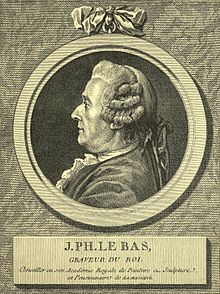Jacques-Philippe Le Bas


Jacques-Philippe Le Bas or Lebas (8 July 1707 - 14 April 1783)[1] was a French engraver.
Life and work
Lebas was engraver to the Cabinet du roi and successfully produced engravings after several paintings by different artists. His oeuvre amounts to more than 500 works, including many large portraits after Vernet, and several works after van de Velde, Parrocel, Berchem, Ruysdaël, Watteau, Oudry and Lancret. He trained the line engraver François-Anne David.
He served time in the army from 1739 to 1741, but was ultimately thrown out, because of philosical disagreements with his commanding officer.
He created many pictures commemorating his time in the army. Of particular mention are his works Halte des Gardes Suisses and Detachement de Cavalerie, pictures that go for great amounts of money at auctions.
Selected works
- The works of mercy, large intaglio plate after David Teniers;
- L’Enfant prodigue, pendant to The Works of Pity, after Teniers;
- A follow-up to Fêtes de village, in intaglio;
- Le Sanglier féroce, large intaglio plate after Philips Wouwerman;
- La Chasse à l’italienne and le Pot au lait, two large intaglio plates after Wouvermans, as a pendant;
- Le Départ de la chasse; la Prise du héron, two intaglio plates as a pendant, after Carel Van Falens;
- Le Rendez-vous de chasse; l’Heureux Chasseur, two plates after the former;
- L’Alliance de Bacchus et de Venus, medium plate after Noël Nicolas Coypel
References
- ^ Portalis & Béraldi, vol. 2.2.
- Ferdinand Hoefer (Ed.). Nouvelle Biographie générale, volume 30 (Paris, Firmin-Didot, 1852) p. 65.
Further reading
- Roger Portalis & Henri Béraldi. Les graveurs du dix-huitième siècle, Vol. 2, pt. 2 (Helman to Marais) (Paris D. Morgand et C. Fatout, 1880) pp. 564–592.
External links
- L'Eau (Water) (artoftheprint.com)
- Ruine Grecque (Greek Ruins) (artoftheprint.com)
- Le Fluteur (The Flutist) (Library of Congress)
